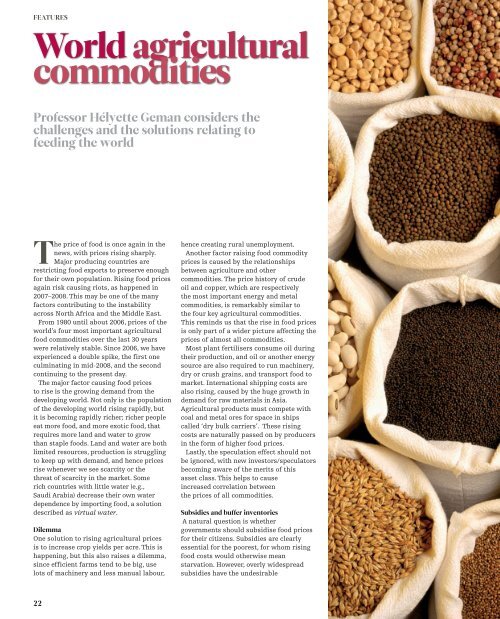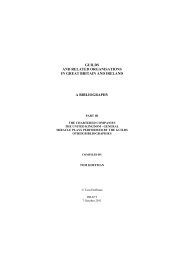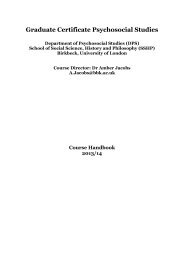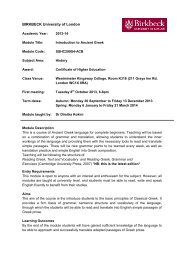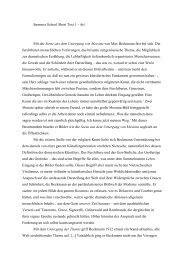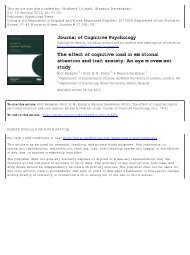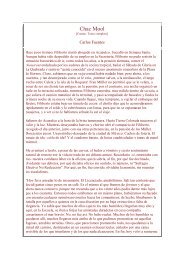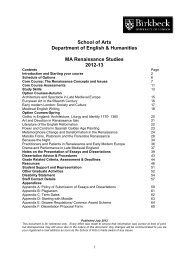Spring 2011 - Birkbeck College
Spring 2011 - Birkbeck College
Spring 2011 - Birkbeck College
You also want an ePaper? Increase the reach of your titles
YUMPU automatically turns print PDFs into web optimized ePapers that Google loves.
FEATURES<br />
World agricultural<br />
commodities<br />
Professor Hélyette Geman considers the<br />
challenges and the solutions relating to<br />
feeding the world<br />
The price of food is once again in the<br />
news, with prices rising sharply.<br />
Major producing countries are<br />
restricting food exports to preserve enough<br />
for their own population. Rising food prices<br />
again risk causing riots, as happened in<br />
2007–2008. This may be one of the many<br />
factors contributing to the instability<br />
across North Africa and the Middle East.<br />
From 1980 until about 2006, prices of the<br />
world’s four most important agricultural<br />
food commodities over the last 30 years<br />
were relatively stable. Since 2006, we have<br />
experienced a double spike, the first one<br />
culminating in mid-2008, and the second<br />
continuing to the present day.<br />
The major factor causing food prices<br />
to rise is the growing demand from the<br />
developing world. Not only is the population<br />
of the developing world rising rapidly, but<br />
it is becoming rapidly richer; richer people<br />
eat more food, and more exotic food, that<br />
requires more land and water to grow<br />
than staple foods. Land and water are both<br />
limited resources, production is struggling<br />
to keep up with demand, and hence prices<br />
rise whenever we see scarcity or the<br />
threat of scarcity in the market. Some<br />
rich countries with little water (e.g.,<br />
Saudi Arabia) decrease their own water<br />
dependence by importing food, a solution<br />
described as virtual water.<br />
Dilemma<br />
One solution to rising agricultural prices<br />
is to increase crop yields per acre. This is<br />
happening, but this also raises a dilemma,<br />
since efficient farms tend to be big, use<br />
lots of machinery and less manual labour,<br />
22<br />
hence creating rural unemployment.<br />
Another factor raising food commodity<br />
prices is caused by the relationships<br />
between agriculture and other<br />
commodities. The price history of crude<br />
oil and copper, which are respectively<br />
the most important energy and metal<br />
commodities, is remarkably similar to<br />
the four key agricultural commodities.<br />
This reminds us that the rise in food prices<br />
is only part of a wider picture affecting the<br />
prices of almost all commodities.<br />
Most plant fertilisers consume oil during<br />
their production, and oil or another energy<br />
source are also required to run machinery,<br />
dry or crush grains, and transport food to<br />
market. International shipping costs are<br />
also rising, caused by the huge growth in<br />
demand for raw materials in Asia.<br />
Agricultural products must compete with<br />
coal and metal ores for space in ships<br />
called ‘dry bulk carriers’. These rising<br />
costs are naturally passed on by producers<br />
in the form of higher food prices.<br />
Lastly, the speculation effect should not<br />
be ignored, with new investors/speculators<br />
becoming aware of the merits of this<br />
asset class. This helps to cause<br />
increased correlation between<br />
the prices of all commodities.<br />
Subsidies and buffer inventories<br />
A natural question is whether<br />
governments should subsidise food prices<br />
for their citizens. Subsidies are clearly<br />
essential for the poorest, for whom rising<br />
food costs would otherwise mean<br />
starvation. However, overly widespread<br />
subsidies have the undesirable


